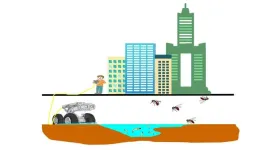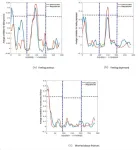(Press-News.org) ANN ARBOR—Young adults ages 19 to 30 nearly doubled their past 12-month use of non-LSD hallucinogens in the United States from 2018 to 2021, according to a study by the University of Michigan and Columbia University.
In 2018, the prevalence of young adults' past-year use of non-LSD hallucinogens was 3.4%. In 2021, that use increased to 6.6%.
"While non-LSD hallucinogen use remains substantially less prevalent than use of substances such as alcohol and cannabis, a doubling of prevalence in just three years is a dramatic increase and raises possible public health concerns. The increase in non-LSD hallucinogen use occurred while LSD use remained stable at around 4% in 2018 and 2021," said study co-author Megan Patrick, research professor in the Survey Research Center at U-M's Institute for Social Research and co-principal investigator of the Monitoring the Future study.
The results, published in the journal Addiction, come from the Monitoring the Future study, conducted by a team of professors at the U-M Institute for Social Research and funded by the National Institute on Drug Abuse, which is part of the National Institutes of Health. In the Monitoring the Future panel study, annual samples of 12th grade students are followed longitudinally into adulthood. The study focuses on substance use and health.
The researchers examined the use of these hallucinogens by sex and found that the use of non-LSD hallucinogens was greater for males. They also found that white young adults used such hallucinogens at a higher rate than Black young adults. Use of non-LSD hallucinogens was also greater for those whose parents had a college education, a proxy for socioeconomic status.
While Monitoring the Future does not identify whether young adults were using these drugs recreationally or because they believed their use to be of therapeutic benefit, previous research has shown that nonmedical hallucinogen use is associated with risks of substance use disorders, injury including self-harm and anxiety, according to the study.
"The use of psychedelic and hallucinogenic drugs for a range of therapeutic uses is increasing, given accumulating yet still preliminary data from randomized trials on clinical effectiveness," said Katherine Keyes, professor of epidemiology at Columbia Mailman School and lead author of the study. "With increased visibility for medical and therapeutic use, however, potentially comes diversion and unregulated product availability, as well as a lack of understanding among the public of potential risks."
The survey did not query whether young adults used non-LSD hallucinogen for a therapeutic or medical reason.
"However, approved therapeutic use of psychedelics under a trained health professional’s care remains uncommon in the U.S., thus the trends we observe here are undoubtedly in nonmedical and nontherapeutic use," Keyes said.
In each survey across young adulthood, from ages 19 to 30, the participants were asked: "How often in the past 12 months have you used LSD?" They were also asked if they had used hallucinogens other than LSD such as mescaline, peyote, "shrooms" or psilocybin, or PCP. Responses ranged from none to 40 times or more. Of the non-LSD drugs listed, "shrooms"/psilocybin had the highest prevalence.
"The use of hallucinogens other than LSD, such as psilocybin in so-called 'shrooms,' has increased among young adults in the U.S. This is a rising concern for young adult health," Patrick said. "We will continue to track these trends to see if the increases continue. We need additional research, including about the motives for hallucinogen use and how young adults are using these substances, in order to be able to mitigate the associated negative consequences."
The research was supported by the National Institute on Drug Abuse of the National Institutes of Health under award numbers R01DA016575 and R01DA001411.
Study: Hallucinogen use among young adults ages 19-30 in the United States: Changes from 2018 to 2021
END
Hallucinogen use other than LSD on the rise among young adults
2023-06-08
ELSE PRESS RELEASES FROM THIS DATE:
Seaweed farming may help tackle global food insecurity
2023-06-08
To help solve hunger and malnutrition while also slowing climate change, some farmers could shift from land to sea, suggests a recent study from the Friedman School of Nutrition Science and Policy at Tufts University. The study was published in Global Food Security.
Producing and selling seaweed could boost incomes for farmers in low- and middle-income countries (LMICs), particularly in coastal regions of Africa and Southeast Asia, said Patrick Webb, the Alexander McFarlane Professor of Nutrition at the Friedman School and senior author of the study. The other ...
Pritzker Molecular Engineering researchers “split” phonons – or sound – in step toward new type of quantum computer
2023-06-08
When we listen to our favorite song, what sounds like a continuous wave of music is actually transmitted as tiny packets of quantum particles called phonons.
The laws of quantum mechanics hold that quantum particles are fundamentally indivisible and therefore cannot be split, but researchers at the Pritzker School of Molecular Engineering (PME) at the University of Chicago are exploring what happens when you try to split a phonon.
In two experiments – the first of their kinds – a team led by Prof. Andrew Cleland used a device called an acoustic beamsplitter ...
Robotic vehicles fight dengue-carrying mosquitos in Taiwan sewers
2023-06-08
Unmanned ground vehicles can be used to identify and eliminate the breeding sources of mosquitos that carry dengue fever in urban areas, according to a new study published this week in PLOS Neglected Tropical Diseases by Wei-Liang Liu of the Taiwan National Mosquito-Borne Diseases Control Research Center, and colleagues.
Dengue fever is an infectious disease caused by the dengue virus and spread by several mosquito species in the genus Aedes, which also spread chikungunya, yellow fever and zika. Through the process of urbanization, ...
Reversing age-related taurine loss via supplementation improves mouse longevity and monkey health
2023-06-08
Taurine deficiency may be a driver for aging, according to a new study, which evaluated the amino acid’s effect on health and longevity across several animal models. According to the authors, reversing age-associated taurine loss via supplementation improved the healthy lifespan in worms, rodents, and non-human primates – findings that warrant further human trials to examine taurine’s effect on healthy lifespan in humans and the potential risks involved. Taurine – a semi-essential micronutrient – is one of the most abundant amino acids in animals. Previous studies in several species have shown that taurine deficiency during early life causes functional ...
2020’s COVID-19 lockdowns altered mammal movements worldwide
2023-06-08
Reduced traffic and human mobility during the 2020 COVID-19 lockdown restrictions rapidly altered some mammals’ movement behaviors, according to a new study. The findings illustrate how human activities constrain animal movement and how they react when those activities cease, which provides valuable insight into future conservation strategies designed to improve human-wildlife coexistence. During the initial global outbreak of COVID-19 in 2020, governments worldwide introduced lockdown measures to curb the spread of the virus, resulting in a drastic reduction in human mobility and vehicular traffic. This “anthropause,” as it’s come to be known, ...
Some intestinal T cells can hinder cancer immunotherapy, while others can enhance it, finds a new pair of studies
2023-06-08
Two new studies in Science and Science Immunology spotlight a group of intestinal T cells with α4β7 integrin receptors that could be targeted to prevent resistance to immune checkpoint blockade (ICB) cancer immunotherapy. Both studies were conducted in mice and corroborated in samples from patients.
In the Science study, Marine Fidelle and colleagues evaluated how interactions between antibiotics, the gut microbiome, and α4β7+ CD4+ T cells promote ...
Climate underlies African forest and savanna biomes
2023-06-08
Coupled field observations and phytoclimatic modeling show that the distribution of African forest and savanna ecosystems are highly predictable by climate, researchers report in a new study. The findings suggest that the effects of climate change on the distribution of African forests and savanna may be more easily forecasted than previously recognized. An important yet challenging goal for ecological science is predicting how global vegetation patterns will be altered by ongoing climate change. Generally, the distribution of Earth’s vegetation biomes is determined by climate. However, at local or regional ...
Wild mammals moved farther during severe COVID-19 lockdowns
2023-06-08
Tucker and 174 colleagues, including members of the COVID-19 Bio-Logging Initiative, analysed global data from land mammals tracked by GPS devices. Tucker: “There were many media reports that nature was recovering during those first lockdowns. For example, cougars were roaming the streets of Santiago, Chile, but we wanted to know: is there any evidence of this? Or were people simply paying more attention to everything while being at home?”
Movements of mammals
Tucker and colleagues collated ...
Study: Southern states may have borne brunt of COVID-19 mental health impact
2023-06-08
LAWRENCE — A new study appearing today in the peer-reviewed journal PLOS ONE shows how federal and state lockdowns and health mandates implemented to curb the spread of COVID-19 affected the mental health of people living in four U.S. geographic regions and affiliated with two major political parties.
A group of faculty, staff and student researchers at the University of Kansas generated data-based maps to look for spatial trends and communities with similar mental health and COVID-19 outcomes. ...
Researchers find an immune system ‘trip wire’ that detects COVID-19
2023-06-08
Inflammasomes make up an intricate system of molecular sensors that our bodies use to sound an alarm when an infection occurs. However, the mechanisms behind these sensors, which initiate responses to threats such as invading pathogens, and how they operate has been an area of intrigue for immunologists.
In a new study, University of California San Diego biologists describe a previously unknown way that the immune system detects certain viruses. The inflammasome immune protein known as CARD8, they found, can serve as a trip wire to detect a range of viruses, including SARS-Cov-2, which causes COVID-19.
Adding ...


